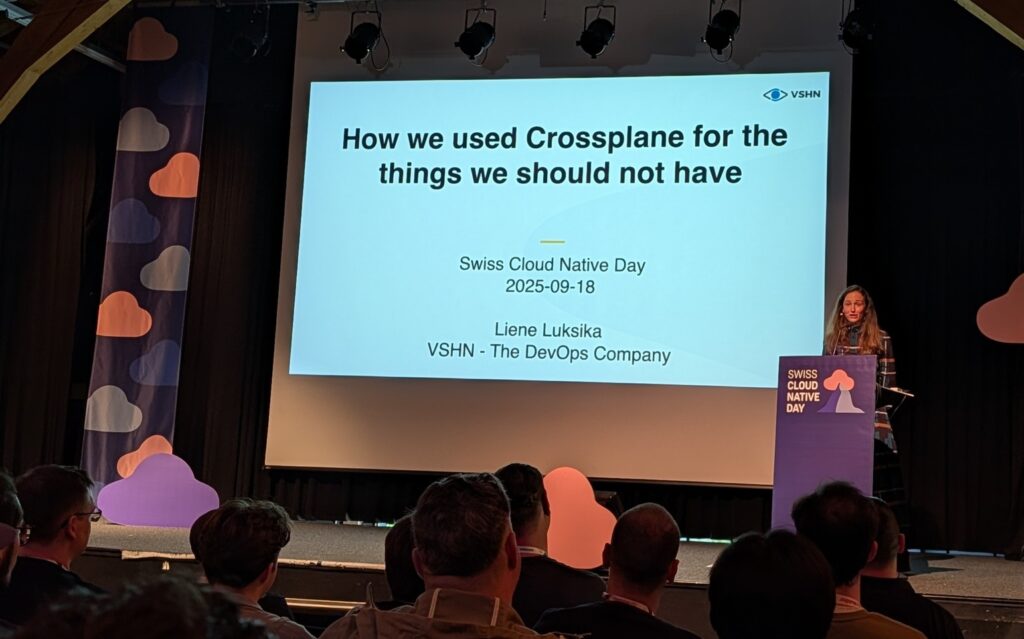How we used Crossplane for the things we should not have



At Swiss Cloud Native Day 2025 in Bern, our colleague Liene Luksika shared an honest and entertaining story about VSHN’s journey with Crossplane. What started as a simple use case evolved into a complex architecture, full of learnings, mishaps, and valuable lessons for anyone building managed services on Kubernetes.
From healthcare to cloud native
Liene comes from the healthcare sector, so when she joined the cloud native world at VSHN, she had to quickly get used to Kubernetes lingo – namespaces, instances, and of course, the obsession with laptop stickers. Luckily, VSHN has been around for more than 10 years, providing 24/7 managed services and building cloud native platforms for customers in Switzerland, Germany, and beyond.
Why Crossplane?
As customers increasingly asked VSHN to run their software as a service – databases, Nextcloud, and other critical apps – we needed a solid way to provision and manage infrastructure across private and public clouds. Crossplane seemed like the perfect fit:
- It lets engineers define desired state vs. observed state
- It automatically reconciles the two – like making coffee appear if that is your desired state
- It provides flexible building blocks to expose clean APIs for managed services on Kubernetes
VSHN has used Crossplane in production since early 2021 (around v0.14) and runs the Crossplane Competence Center in Switzerland.
The evolution: from simple to complex
Our first use case was straightforward: a customer wanted two types of databases (Redis and MariaDB), T-shirt sized, no extras. Crossplane handled this beautifully.
Then reality hit. Customers wanted backups and restores, logs and metrics, alerting, maintenance and upgrades, scaling and user management, special features like Collabora for Nextcloud, and the freedom to choose infrastructure. To serve this, we adopted a split architecture:
- A control cluster for all Crossplane logic
- Separate service clusters for customer workloads
This runs today with customers like health organizations in Gesundheitsamt Frankfurt and HIN in Switzerland, on providers such as Exoscale and Cloudscale, keeping data sovereign and operations reliable.
When things go wrong
Building complex platforms means learning in production:
- Deletion protection surprise: a minor Crossplane change removed labels before deletion, wiping our safeguard. Backups saved the day
- Race conditions: a split approach to connection details occasionally made apps unreachable until we cleaned up code
- The big one: during a planned “no-downtime” maintenance for a fleet with 1’300+ databases, objects hit an invalid state and Kubernetes garbage collection deleted 230 database objects. Some restores were fresh, some older. We pulled in 20 people overnight, communicated openly, and recovered together with the customer
Key lessons: test at realistic scale and keep recent, tested backups. Also, practice the restore path, not just the backup.
Crossplane 2.0 – where next?
Crossplane 2.0 introduces major breaking changes. Staying put is not an option, but migrating means real effort, especially for our split control plane architecture. We are evaluating whether Crossplane 2.0 fits our needs or if alternatives are a better match. As always, we will document our decisions openly in VSHN’s Architecture Decision Records.
Final thoughts
Cloud native success is not just about tools. It is about learning fast, designing for failure, and communicating clearly with customers. Crossplane has enabled a lot of innovation for us, and it has also tested us. Whether we proceed with Crossplane 2.0 or chart a different course, we will keep building sovereign, reliable, open managed services for our customers.
👉 Watch the whole video on YouTube: